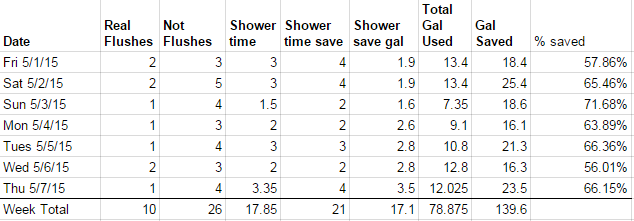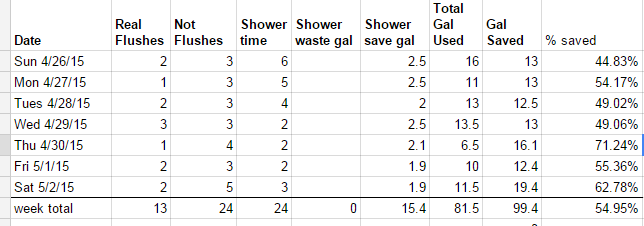Shortly after moving into our new-to-us 1954 single family Cape we of course started discovering issues. One was that the water pipes inside the house were all only half-inch diameter – smaller than more modern houses.The result is that in order to get sufficiently warm water for my 6am 2nd floor shower I must run the shower for up to a minute or more before I dare to step in.
One feature I like is the older 3.5 gallon size toilet – even though modern low-flow toilets use only 1.5 gallons per flush I found myself needing to snake through clogs in the ones we installed in our old house at least once a month.
But after a full 3-month water billing cycle showed we were using the maximum amount in the lowest price tier (up to 15 CCF per cycle – “CCF” = Cento Cubic Feet = 748 gallons per CCF) I decided to work on offsetting the inefficient toilet and shower routines.
By implementing a few small changes to my bathroom routine, in the first week I cut my net water use in half, saving nearly 100 gallons! Here’s how:
1. Get a Bucket
I got this 5-gallon OXO Good Grips Angled Measuring Bucket because I wasn’t sure how much water was needed to get the shower up to temperature. It turns out that due to my low-flow shower head it’s running at about 1.5 gal/minute so takes 1.5-2.5 gallons depending on whether the shower is the first call to the hot water tank made that morning. But I like it anyway, both for its oblong shape and that the interior markings make it easy to see how much water it contains.
2. Put It Into The Shower Under The Showerhead
I have a handheld showerhead with a 5-foot connecting hose and a shut-off switch, in the style of this one:
So I can just put the showerhead into the bucket, turn on the shower water, and check the temperature every 10-20 seconds with my hand (usually I turn it on, weigh myself, then check the water).
3. Get Into The Shower
When the temperature is right I get in and take my shower. I place the bucket so that it will continue to collect water with the showerhead mounted on the wall and facing slightly away from me. I don’t want to get a lot of shampoo, soap, etc into the bucket, so I hold the showerhead to spray/rinse myself then put it back on its wall mount when soaping up, shaving, etc. For bonus points, if you have a switch on the handle shut off the water flow until you need it – I also started doing this.
4. Store The Bucket of Water in the Shower Stall
… with the door closed to keep out pets and children until you are ready to use it.
“Use it for what?” you ask – for saving water in the toilet!
A. Don’t Flush Every Time you Pee
Unless you use a lot of toilet paper, you can easily go several “trips” without flushing. Just keep the lid down to keep out pets/children.
B. Use The Bucket of Water When It’s Time To Flush
When you have enough “material” to warrant flushing, you could just pour the water into the toilet bowl – but whether that will result in a full flush depends on how much water you have in the bucket.
I prefer to:
- Remove the top of the toilet tank
- Flush the toilet
- When the flap inside the tank flaps down to seal the tank (after it has refilled the bowl) pour your bucket of water into the tank. Stop when the float rises enough to shut off the refill valve if you have more water than necessary for the tank refill. [Note: one reason I prefer this method is my fill valve doesn’t always shut off without a manual intervention].
How much does this save? Below is a chart of my first week. “Not Flushes” = times I used the toilet but didn’t flush; “Shower Save Gal” = the water in the bucket; “Shower waste” would be if I didn’t have the bucket (See next image – I changed the chart a bit the folowing week). Wednesday I added an extra flush to account for the cleaning service :-)
Part-way through I also added a water-resistant timer to record how long I was actually running the shower vs having it off, rather than just using the total time I was in the shower to calculate water use. That’s “Shower time save” below. “Gal saved” is calculated:
[not flushes # times 3.5 gal saved] + [shower time saved times 1.5 gal] + Shower Save Gal (which is the bucket contents)

So instead of using 218 gallons in a week I used 79 gallons, a 64% savings!

